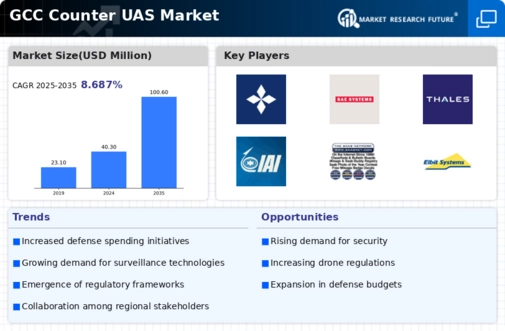Rising Security Concerns
The counter uas market is experiencing growth driven by escalating security concerns across various sectors in the GCC. Governments and private entities are increasingly aware of the potential threats posed by unauthorized drones, particularly in sensitive areas such as airports, military installations, and critical infrastructure. This heightened awareness has led to a surge in demand for counter uas solutions, as stakeholders seek to protect their assets and ensure public safety. According to recent estimates, the market is projected to grow at a CAGR of approximately 15% over the next five years, reflecting the urgency to address these security challenges. The counter uas market is thus positioned to benefit from this trend, as investments in advanced detection and neutralization technologies become a priority for both public and private sectors.
Technological Integration
The integration of advanced technologies into counter uas systems is a key driver for the counter uas market. Innovations such as artificial intelligence, machine learning, and advanced radar systems are enhancing the effectiveness of counter uas solutions. These technologies enable real-time threat assessment and response, significantly improving operational efficiency. In the GCC, the adoption of such technologies is expected to increase, with market analysts predicting a growth rate of around 20% in the next few years. This trend indicates a shift towards more sophisticated counter uas systems that can adapt to evolving threats. The counter uas market is likely to see a proliferation of integrated solutions that combine various technologies to provide comprehensive protection against drone threats.
Commercial Sector Expansion
The expansion of the commercial sector in the GCC is contributing to the growth of the counter uas market. As industries such as logistics, construction, and agriculture increasingly adopt drone technology for operational efficiency, the need for counter uas solutions becomes more pronounced. Companies are recognizing the potential risks associated with drone usage, including privacy violations and safety hazards. Consequently, there is a growing demand for counter uas systems to mitigate these risks. Market projections suggest that the commercial segment could account for over 30% of the total counter uas market by 2026. This trend indicates a shift in focus towards protecting commercial interests, thereby driving the counter uas market forward.
Government Initiatives and Funding
Government initiatives aimed at enhancing national security are significantly influencing the counter uas market. In the GCC, various governments are allocating substantial budgets to develop and implement counter uas capabilities. For instance, recent reports indicate that defense budgets in the region are expected to increase by 10% annually, with a portion specifically earmarked for counter uas technologies. This financial commitment reflects a strategic focus on safeguarding airspace and critical infrastructure from drone-related threats. The counter uas market stands to gain from these initiatives, as public sector investments drive innovation and the development of new solutions tailored to the unique challenges faced in the region.
International Collaboration and Partnerships
International collaboration among GCC nations is emerging as a significant driver for the counter uas market. Countries in the region are increasingly engaging in joint initiatives to enhance their counter uas capabilities, sharing knowledge, technology, and best practices. This collaborative approach not only strengthens national security but also fosters innovation within the counter uas market. Recent agreements between GCC nations to develop unified counter uas strategies suggest a commitment to addressing shared security challenges. Such partnerships are likely to lead to the development of more effective and comprehensive counter uas solutions, further propelling market growth in the coming years.

















Leave a Comment